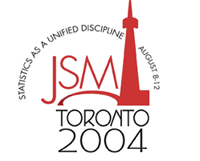|
Activity Number:
|
47
|
|
Type:
|
Topic Contributed
|
|
Date/Time:
|
Sunday, August 8, 2004 : 4:00 PM to 5:50 PM
|
|
Sponsor:
|
Section on Statistics and the Environment
|
| Abstract - #300670 |
|
Title:
|
Hierarchical Bayesian Models for Seasonal Radio Telemetry Habitat Data
|
|
Author(s):
|
Megan C. Dailey*+ and Alix I. Gitelman and Fred L. Ramsey
|
|
Companies:
|
Colorado State University and Oregon State University and Oregon State University
|
|
Address:
|
Dept. of Statistics, Fort Collins, CO, 80523-1877,
|
|
Keywords:
|
radio telemetry ; habitat selection ; Bayesian ; persistence
|
|
Abstract:
|
Radio telemetry data used for habitat selection studies typically consists of a sequence of habitat types for each individual indicating habitat use over time. Existing models for estimating habitat selection probabilities have incorporated covariates in an independent multinomial selections (IMS) model and an extension of the IMS to include a persistence parameter. These models assume that all parameters are fixed through time. However, this may not be a realistic assumption in radio telemetry studies that run through multiple seasons. We extend the IMS and persistence models using a hierarchical Bayesian approach that allows for the selection probabilities, the persistence parameter, or both, to change with season. These extensions are particularly important when movement patterns are expected to be different between seasons, or when availability of a habitat changes throughout the study period due to weather or migration. The models are motivated by radio telemetry data for fish in which seasonal differences are expected and evident in the data.
|
